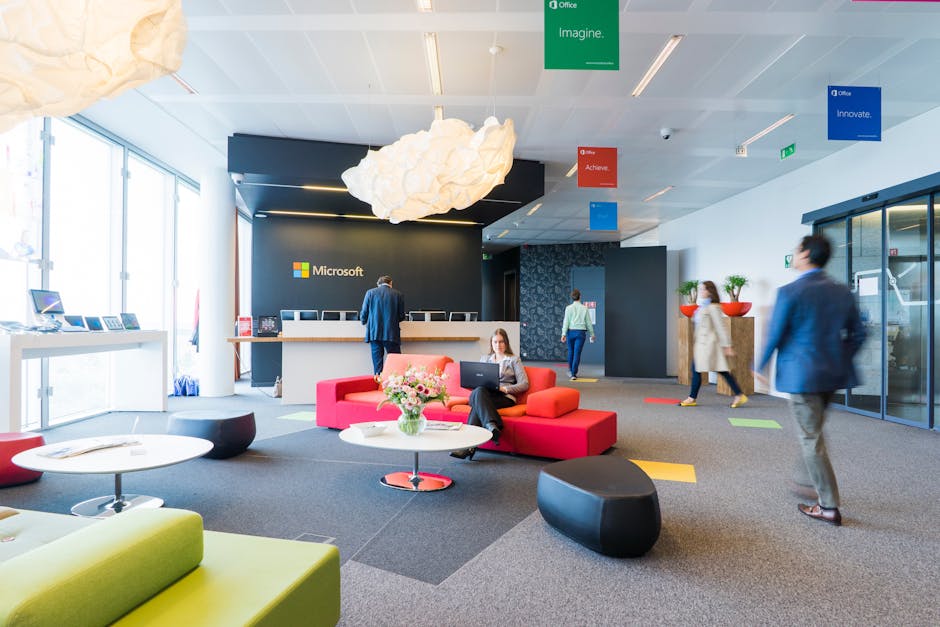Revolutionizing Workspaces: The Power of Office Neighborhoods
“Office neighborhoods are reshaping the modern workplace, offering a dynamic approach to space utilization and employee collaboration. This article explores the concept, benefits, and implementation strategies of office neighborhoods, providing insights for businesses looking to enhance their work environment. ”

Reimagining the Workplace: The Rise of Office Neighborhoods
In today's rapidly evolving business landscape, companies are constantly seeking innovative ways to enhance productivity, foster collaboration, and optimize their workspace. Enter the concept of office neighborhoods – a revolutionary approach to workplace design that's transforming how we think about and interact within our professional environments.

What Are Office Neighborhoods?
Office neighborhoods are dynamic workspace layouts designed to mimic the collaborative and communal aspects of residential communities. By dividing the office into distinct areas or "neighborhoods," each with its own purpose and character, organizations can create a more varied and functional work environment that caters to different tasks, work styles, and team dynamics.
The Benefits of Implementing Office Neighborhoods
Enhanced Collaboration and Communication
One of the primary advantages of office neighborhoods is the improved collaboration they foster. By creating dedicated spaces for team-specific or activity-based work, employees from various departments can more easily interact, share ideas, and work together on projects. This cross-pollination of ideas can lead to increased innovation and problem-solving capabilities within the organization.
Increased Productivity and Focus
Office neighborhoods allow for the creation of spaces tailored to specific tasks or work modes. This means employees can choose the most appropriate area for their current project, whether it's a quiet zone for focused work or a collaborative space for brainstorming sessions. This flexibility can significantly boost individual and team productivity.
Optimized Space Utilization
Maximizing office space utilization is a key concern for many businesses, especially in urban areas where real estate comes at a premium. Office neighborhoods offer a solution by creating multi-functional spaces that can be adapted to changing needs, ensuring that every square foot of the office is put to good use.
Improved Employee Satisfaction and Well-being
By providing a variety of work settings, office neighborhoods cater to different work preferences and styles. This autonomy in choosing where and how to work can lead to increased job satisfaction, reduced stress, and improved overall well-being among employees.

Types of Office Neighborhood Layouts
Team-Specific Neighborhoods
These layouts group employees based on their departments or project teams. This arrangement facilitates easy communication within teams and allows for the customization of spaces to suit specific team needs.
Activity-Based Neighborhoods
Activity-based layouts focus on creating areas designed for particular types of work, such as quiet zones for focused tasks, collaborative spaces for group projects, and social areas for informal meetings and breaks.
Open Seating Neighborhoods
Open seating layouts promote flexibility and cross-team interaction by allowing employees to choose their work location daily. This can be particularly effective in fostering a sense of community and breaking down departmental silos.
Implementing Office Neighborhoods: Best Practices
1. Understand Your Organization's Needs
Before redesigning your workspace, conduct thorough research to understand how your employees work and what types of spaces would best support their activities. Workplace occupancy data can provide valuable insights into space usage patterns.
2. Involve Employees in the Design Process
Engage your team members in the planning and design of office neighborhoods. Their input can help ensure that the new layout meets their needs and increases buy-in for the changes.
3. Invest in Supportive Technology
Implement technology solutions that support the flexible nature of office neighborhoods. This might include digital signage for meeting rooms, desk booking systems, and collaboration tools that facilitate seamless work across different areas of the office.
4. Create Clear Guidelines
Establish and communicate clear guidelines for using different neighborhoods. This helps ensure that spaces are used as intended and that all employees understand how to navigate and utilize the new layout effectively.
5. Iterate and Adapt
Be prepared to make adjustments based on feedback and observed usage patterns. The beauty of office neighborhoods lies in their flexibility, so don't be afraid to refine the layout over time to better meet your organization's evolving needs.

Conclusion: Embracing the Future of Work
Office neighborhoods represent a significant shift in workplace design philosophy, moving away from rigid, one-size-fits-all layouts to more dynamic, adaptable spaces that support diverse work styles and activities. By implementing this innovative approach, organizations can create environments that not only boost productivity and collaboration but also enhance employee satisfaction and well-being.
As we continue to navigate the changing landscape of work, office neighborhoods offer a promising solution for businesses looking to create more engaging, efficient, and flexible workspaces. By carefully considering your organization's unique needs and following best practices for implementation, you can transform your office into a thriving ecosystem of productivity and innovation.
Remember, the key to successful office neighborhoods lies in their ability to evolve. Stay open to feedback, monitor usage patterns, and be willing to adapt your spaces as your organization grows and changes. In doing so, you'll create a workplace that not only meets the needs of today but is also prepared for the challenges and opportunities of tomorrow.